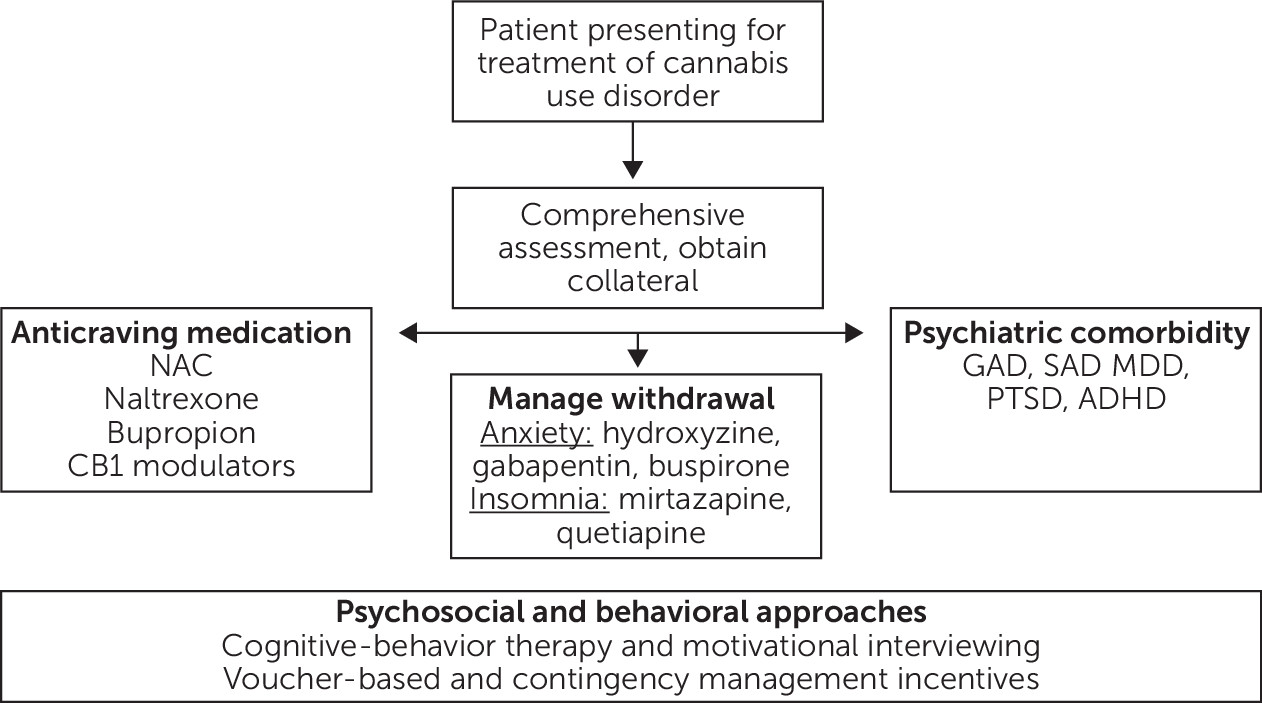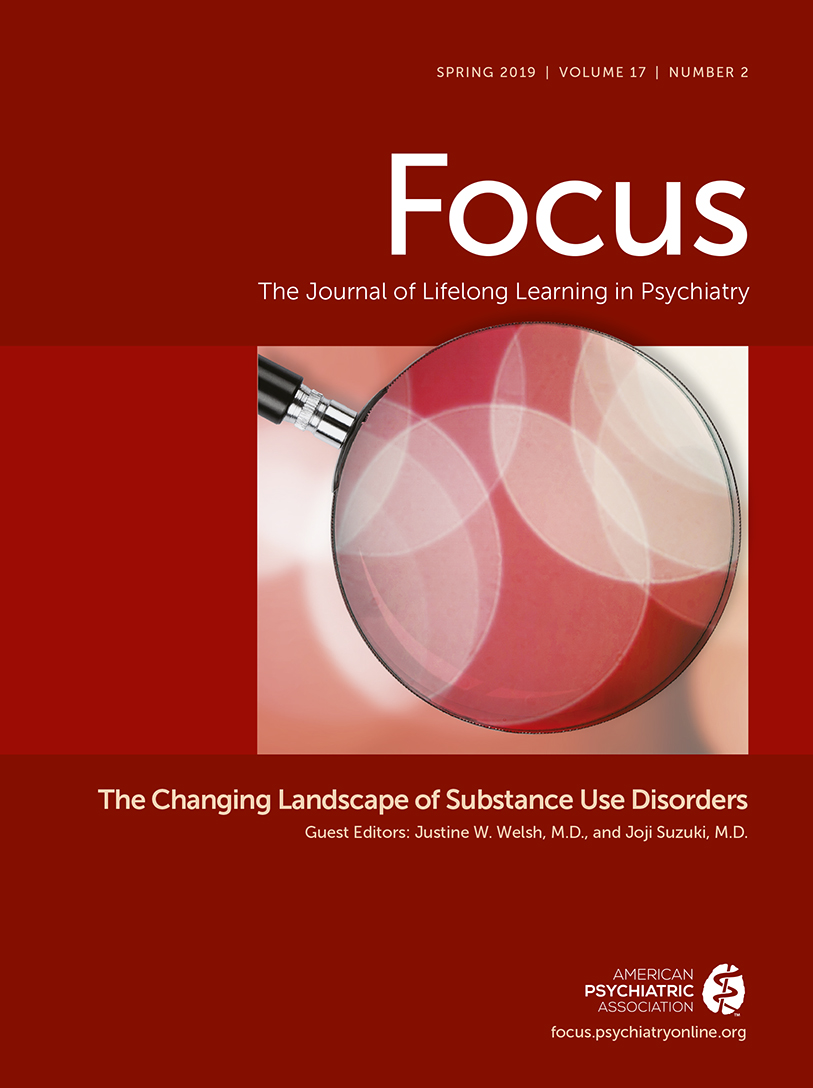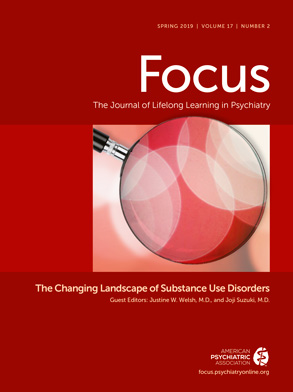Cannabis is the most commonly used illicit drug in the world, and in the United States, it is increasingly becoming a commonly used legal drug, at least under an expanding array of state-level laws. As of the November 2018 election, 10 states and Washington, DC, have passed laws allowing both medical and recreational use of cannabis (
1). An additional 23 states (
1) allow medical cannabis programs of varying design (
2). Finally, since 2013, 13 states (some of which also allow medical cannabis) have authorized the use of cannabidiol (CBD), primarily for patients with seizure disorders and research studies. In this article, however, we do not address CBD, one of 100-plus cannabinoids in the cannabis plant, which does not have addictive liability when used alone.
Can Cannabis Be Addictive?
Remarkably, despite daily use of cannabis being at record high levels among high school students and college-age adults, many individuals, including clinicians, are unaware that cannabis can be addictive. Flawed drug awareness campaigns of the 1990s claimed that cannabis could be psychologically addictive but not physically addictive like other drugs. However, cannabis does predictably cause physical dependence—the hallmarks of which are tolerance and withdrawal—and heavy users may have great difficulty in attempting to reduce or end their use, leading to compulsive, continued use and related consequences (
3,
4). In addition, although study findings have been mixed, it is apparent that at least for some individuals with vulnerabilities, heavy cannabis use is associated with increased risk of anxiety, depression, and psychosis (
5). Early onset of cannabis use in particular has been associated with worse cognitive functioning and declines in IQ, although interpretations of findings and causality related to neuropsychological effects have been controversial (
5,
6).
Historically, the addictions field has reported that among cannabis users (i.e., those who have used more than several times), the risk of developing cannabis use disorder is one in 11 for adults (approximately 9%) and rises to one in six for adolescent users (17%). However, the potency of tetrahydrocannabinol (THC), the primary psychoactive cannabinoid in cannabis, has increased dramatically since the 1990s, now often surpassing 12%-20%, approximately four times the strength of cannabis predating the 21st century (
7,
8). As a result, how increased potency will affect the addictive liability of cannabis is unclear, especially among users who “dab” or use concentrates (“wax” or “shatter”) that can surpass 90% THC. Adding further confusion, cannabis-derived products, notably “edibles” such as candies and brownies, are now mass produced and commercially advertised for medical and recreational purposes. Because absorption and metabolism of orally ingested cannabis vary greatly by individual, studies have not yet been able to characterize the addictive profile of alternative forms of cannabis ingestion. Of great concern, recent large federally funded studies, such as the National Epidemiologic Survey on Alcohol and Related Conditions-III (NESARC-III; data collected in 2012-2013), have suggested that among adult cannabis users (past year), upward of 30% meet diagnostic criteria for cannabis use disorder (see
Table 1) (
9).
In 2010, the prevalence of cannabis use disorder (formerly termed
cannabis abuse and
cannabis dependence under
DSM-IV-TR) among persons ages 12 years and older in the United States was estimated to be 1.8%, representing 4.5 million individuals (
10). As of 2017, the prevalence of cannabis use disorder was estimated by some to be largely stable (
11), but data from the 2012-2013 NESARC-III suggest a dramatic increase to approximately 7 million adults (
9). Regardless, rates of adult use and daily adult use have risen substantially, likely reflecting the influence of broader access to legal cannabis among adults through both medical and recreational dispensaries (
12).
Consistent with drug use generally, risk factors associated with cannabis use include a lifetime history of drug use disorder and past-year alcohol use disorder, both of which are associated with roughly a fivefold increase in the likelihood of cannabis use (
10). Stressful life events and cigarette smoking have also been associated with lifetime cannabis use, and they may exert relatively greater influence on women’s likelihood of cannabis use (
10).
Cannabis (and cannabinoid-derived product) intoxication can include relaxation and anxiolysis, euphoria, altered perception and awareness of external stimuli, and increased appetite (
13). Symptoms of intoxication typically intensify over one to two hours of use, coinciding with peak plasma levels of THC (
14), and these symptoms may be unpleasant for about 30% of individuals who report discomfort or anxiety when using cannabis. Common but undesirable changes after use may include impaired coordination and motor skills, memory loss (anterograde) and learning difficulties, and injected or reddened conjunctiva. Frequent cannabis users, however, tend to build a tolerance to many of these symptoms, especially cognitive disturbances.
A substantial body of research has identified a number of risk factors for the development of cannabis use disorder, including sexual abuse (especially during childhood), vulnerable family environments and family history of substance use disorders, antisocial behavior and impulsivity, early-onset anxiety disorders, and substance use, among others (
10). Risk factors are interconnected and unlikely to act in isolation; for example, childhood traumas are well known to be related to later mood and anxiety disorders, and these disorders may mediate their eventual effects on substance use disorders.
In a review of Wave 2 NESARC data (collected in 2004–2005), Blanco and colleagues found that among cannabis users, risk factors for the development of cannabis use disorder include past-year alcohol use disorder (adjusted odds ratio [AOR]=4.09), impulsivity (AOR=2.18), greater number of axis I disorders (AOR=1.56), and social deviance (AOR=1.19). Factors that have been found to be protective against cannabis use disorder include religious service attendance and a strong support system (
10). In their study, Blanco and colleagues found that 9% of adults reporting cannabis use (not necessarily active or daily users) transitioned to cannabis use disorder (per
DSM-IV dependence criteria), with half developing cannabis use disorder within 4 years of cannabis initiation (
10), relatively shorter than the 13 years observed among alcohol users who subsequently developed alcohol use disorder (
15).
Notably, unlike other substance use disorders in which patients have more visible or outwardly disruptive consequences of heavy use (such as overdose or violent and injurious acts, as seen with opioids and stimulants), individuals with cannabis use disorder are often unaware of their addiction for many years and may continue frequent use without the notice of others, including health care providers. Similar to declines in functioning associated with the negative symptoms of schizophrenia or dementia, the slowly accumulating dysfunction resulting from cannabis use disorder can be hard to detect.
Amotivational syndrome is a term that refers to the lack of motivation, declines in functioning and activity levels, and apathy common among heavy cannabis users (
16). Given that rates of cannabis use disorder are higher among cannabis users with comorbid anxiety, mood, personality, psychotic, and attention-deficit disorders, it can be difficult to ascertain the primary drivers of functional decline for an individual patient.
Similar to patients presenting to treatment for other substance use disorders, those with cannabis use disorder are often referred via the criminal justice system (e.g., diversion programs, drug courts, probation officers; approximately 50%) or brought in by concerned family members. Cannabis is the drug most commonly reported in treatment admissions, according to the Substance Abuse and Mental Health Services Administration (
17). It is not uncommon for patients seeking treatment to report that they did not realize they were addicted to cannabis until they needed to pass a pre-employment drug test or went on a trip without access to cannabis. On trying to stop and experiencing debilitating withdrawal symptoms (cardinal symptoms are insomnia, anorexia, anxiety, irritability, and restlessness), some patients realize they can no longer control their drug use and seek help. In hospital settings, acute cannabis withdrawal is almost universally missed by health care staff, yet it contributes to insomnia, anxiety, and irritability for regular users who are suddenly separated from active use.


